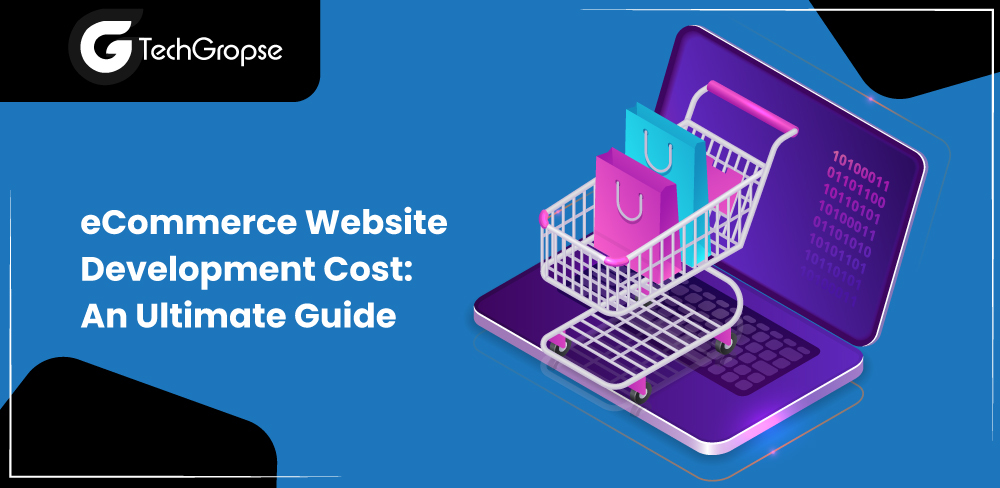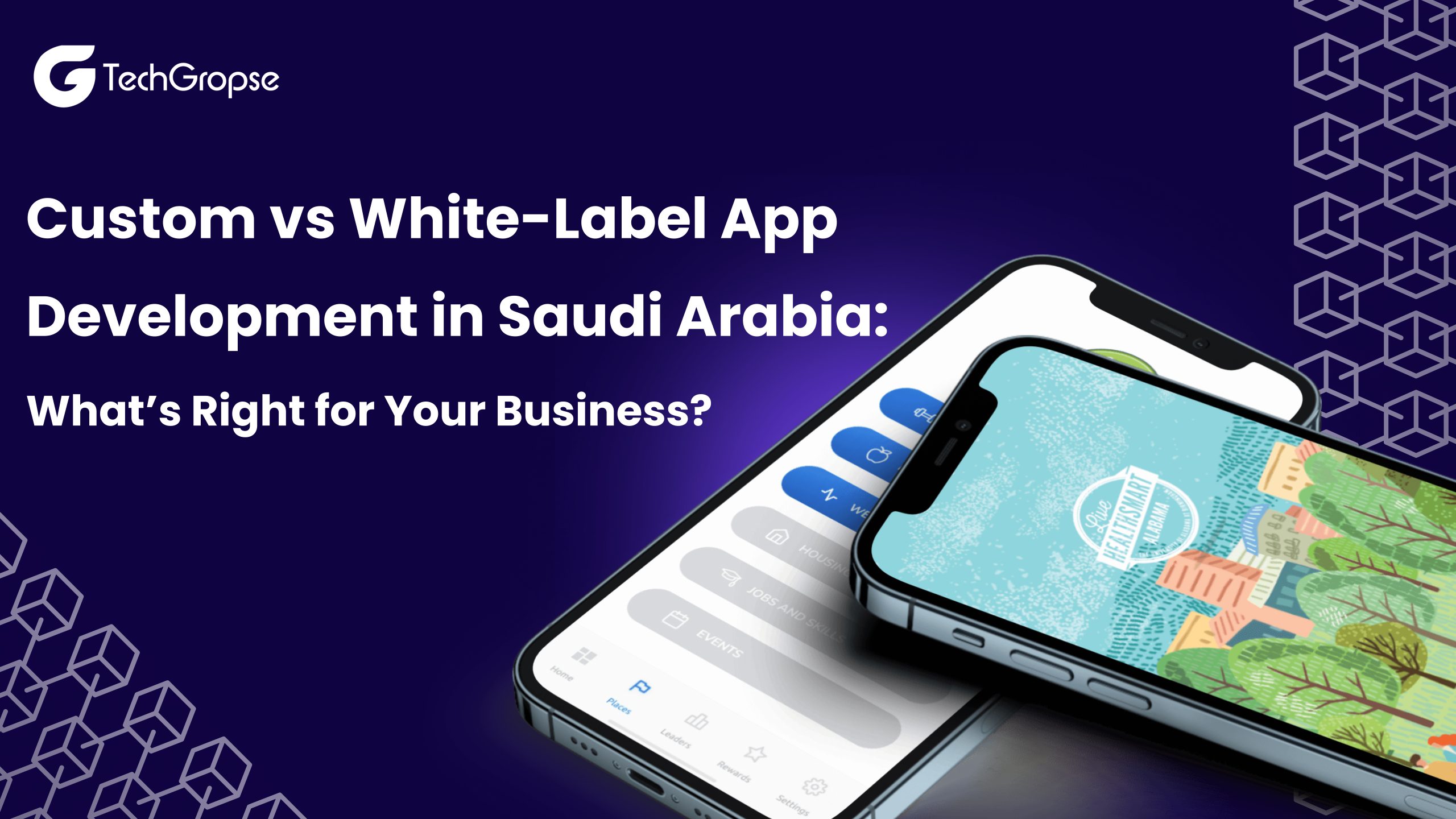“Grow your online dreams with an outstanding eCommerce website! Our experts are ready to turn your idea into a seamless digital storefront. Remember that, eCommerce Website Development Cost is an investment to make your business successful.”
Imagine your dad, who’s been running his business for, like, forever, decides to pass the torch to you. He has done an amazing job and made the business super successful.
Now, it’s your time to take a handle and make it bigger and better. But here’s the thing: people are all about shopping online these days, and that’s kinda freaking you out.
But don’t worry, you got this! You can manage all the situations and come out on the next level.
So, when it comes to this situation, you have got two choices. You can either keep doing things the usual way or you can bring your work online by making a website.
What do You Think is the Right Approach? Let us know!
But what do we think? Well, websites are like the stores of the future and they’re super important for every organization.
They help businesses grow and make more sales while keeping customers coming back for more. Did you know that 64% of small businesses today have a website, either fully or partially?
But still, a lot of people get confused about how much it costs to make a website and where to find the best eCommerce website development company to help with it.
So, if you want to build ecommerce website carefully plan your budget, explore the cost of building ecommerce website, and hire the right professionals. You can create a successful eCommerce website without draining your bank account.
This post has all the info you need about the eCommerce website development cost in 2023 and what factors can affect it.
Current Global eCommerce Development Statistics
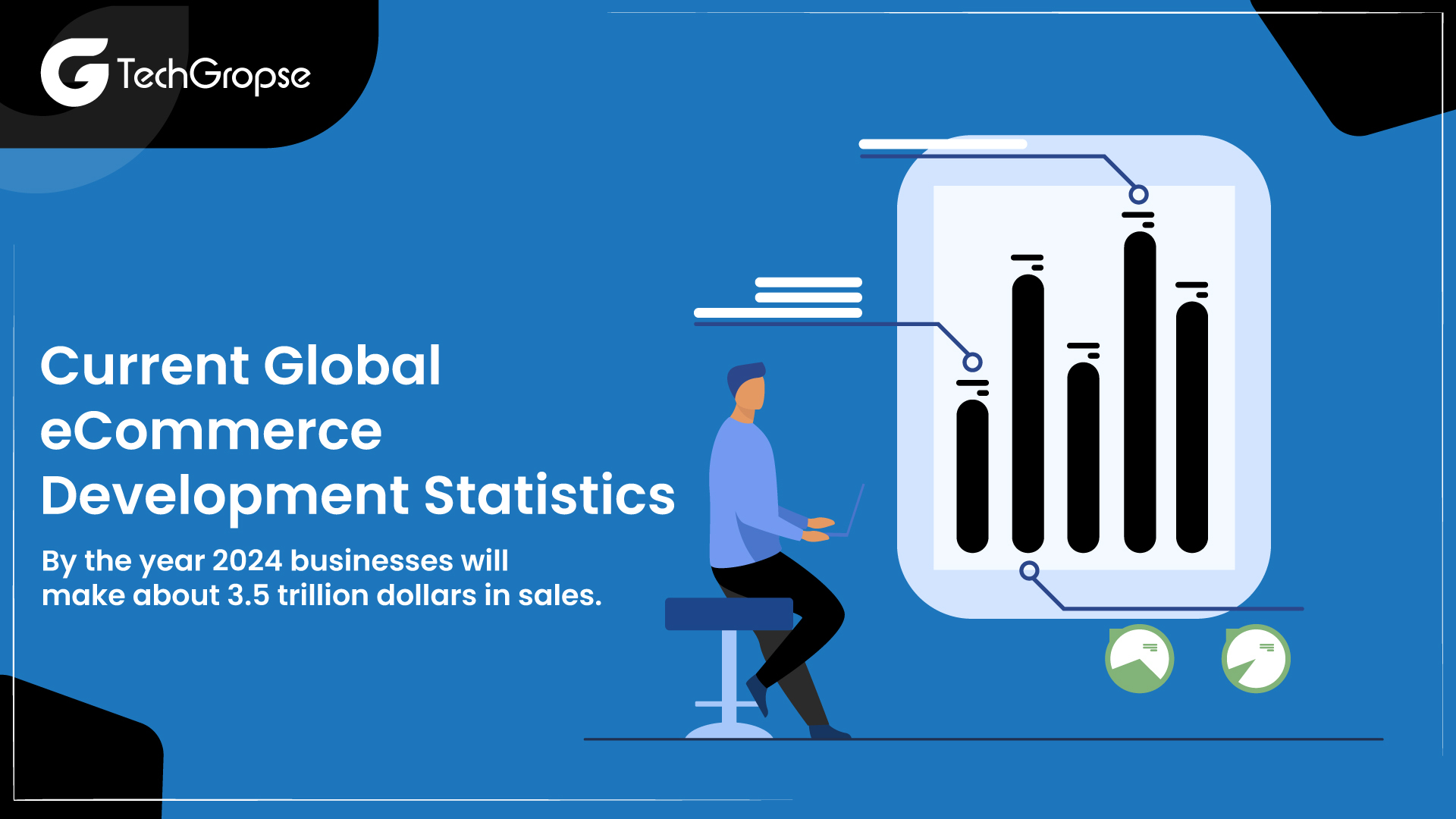
Check out these latest numbers that show what’s happening in the online shopping world. Take a peek at the numbers and figure out how to make awesome plans for your business.
|
Importance of eCommerce Websites
In today’s digital age, having an eCommerce website is crucial for businesses looking to thrive in the online marketplace.
eCommerce website development company knows the world of online business has seen exponential growth over the years, with more and more businesses recognizing the importance of having a strong online presence.
One of the essential aspects of selecting an online business is building an eCommerce website. Before delve on to eCommerce website development cost, you should know it allows businesses to sell their services or products online, getting a global audience 24/7.
With the growing trend of online shopping, having a user-friendly and well-designed eCommerce website can boost sales and earnings.
However, creating an online shopping website needs unique planning, consideration, and investment.
How Much Does it Cost to Develop an eCommerce Website Like Flipkart?
Now you may think “What is the cost of developing an ecommerce website?” Well, the cost of creating a user-friendly website depends on a lot of things, like how many features you want to have.
If you want an appealing website with lots of unique stuff, it’s gonna cost more. The web development cost also changes depending on how big your business is and how long it takes to make the website.
If you don’t want to build the website yourself, you can hire dedicated developers to do it easily. There are two famous ways to pay them.
- One way is called pay-as-you-go, which is good if you just need help with maintaining the website.
- The other way is called project fixed price, which is better if you want to plan out the whole project and have a set budget.
It’s always a good idea to try to make the website as quickly and accurately as possible to save money.
| Elements | Small Scale | Medium Scale | Large Scale |
| Design | Less than $1000 | $1,000 to $5,000 | $10,000 to $80,000 |
| Functionality | Less than $2000 | $5,000 to $12,000 | $20,000 to $100,000 |
| Fulfillment | Free of Cost | $30 to $400 | $5,000 |
| Marketing | $0 to $500 | $500 to $2,000 | $5,000 |
| Maintenance | $0 to $500 | $500 to $3,000 | $4000 to $12,000 |
| Essentials | $300 | $5,000 to $6,000 | $10,000 |
How Many Hours Does It Take to Build an Ecommerce Website?
It is quite challenging to provide precise hours as the time required to build an eCommerce website can vary significantly based on factors like complexity, features, design, development speed, and team expertise.
However, an online shopping app development company can give you a rough estimate in a table form based on different project sizes:
| Project Size | Estimate Hours | Time Frame |
| Small Scale | 150 – 300 hours | 2 – 4 weeks |
| Medium Scale | 300 – 600 hours | 4 – 8 weeks |
| Fulfillment | 600+ hours | 8+ weeks |
Factors Affecting eCommerce Website Development Cost
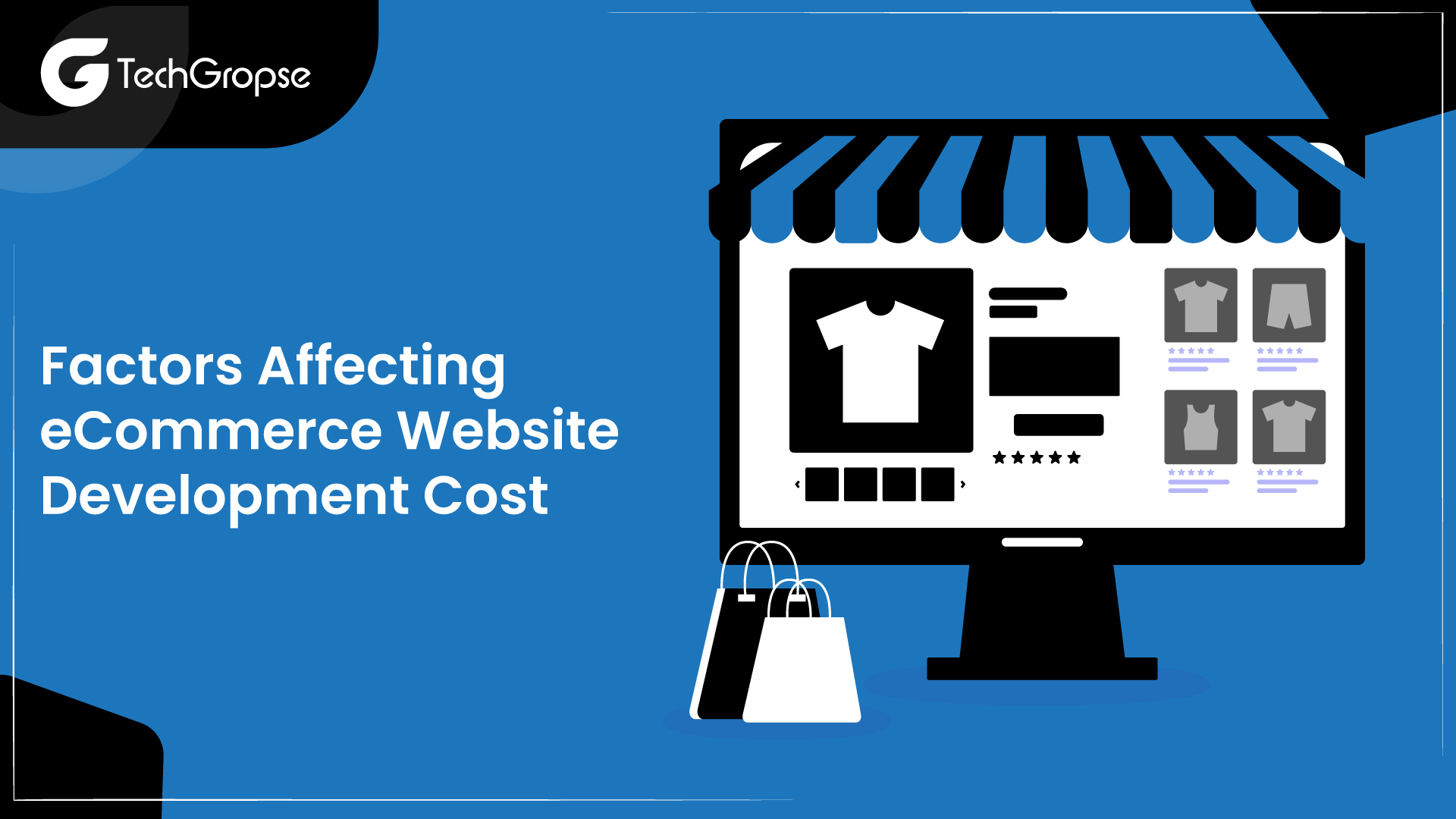
The eCommerce website development cost can vary widely based on several influential factors.
Here are key factors that contribute to the overall cost to build ecommerce website:
1. Website Complexity
- Description: The complexity of the website, including its design, functionality, and features, significantly impacts development costs. A basic e-commerce site with standard features will cost less than a complex platform with advanced functionalities.
- Example: A simple online store selling a few products vs. a sophisticated e-commerce platform with personalized user experiences and AI-driven recommendations.
2. Platform Choice
- Description: The choice of an e-commerce platform, whether it’s a custom-built solution or a pre-existing platform (e.g., Shopify, Magento, WooCommerce), affects development costs. Custom solutions tend to be more expensive but offer greater flexibility.
- Example: Developing a custom e-commerce website vs. using a platform like Shopify.
3. Design and User Experience (UX)
- Description: A visually appealing and user-friendly design is crucial for attracting and retaining customers. The complexity of the design, the need for custom graphics, and the emphasis on user experience contribute to costs.
- Example: Investing in a unique, custom design vs. using a pre-designed template.
4. Payment Gateway Integration
- Description: A website development company integrating secure and reliable payment gateways involves additional costs. The number of payment options, such as credit cards, digital wallets, and other online payment methods, can impact the overall expense.
- Example: Integrating PayPal, Stripe, or other payment gateways.
5. Product Catalog Size
- Description: The number of products and categories in your catalog affects eCommerce website development cost. A large product catalog may require additional features like advanced search, filtering, and categorization.
- Example: A small boutique with a limited product range vs. a large online marketplace with thousands of products.
6. Mobile Responsiveness
- Description: Ensuring the website is mobile-responsive is crucial as a significant portion of e-commerce traffic comes from mobile devices. The eCommerce website development cost may depend on the level of optimization needed.
- Example: A website optimized for mobile devices vs. one that requires additional mobile development.
7. Security Features
- Description: Implementing robust security features like SSL certificates, encryption, and secure payment processing, is essential for protecting customer data. Enhanced security measures may increase costs.
- Example: Implementing HTTPS and SSL certificates for secure transactions.
8. SEO and Marketing Integration
- Description: Integrating search engine optimization (SEO) features and marketing tools affects costs. These interesting features improve visibility on search engines and support online marketing efforts.
- Example: Implementing SEO-friendly URLs, and meta tags, and integrating with marketing tools.
9. Custom Functionality
- Description: Any additional custom functionalities, such as customer accounts, wish lists, product recommendations, or integration with third-party services, can increase development costs.
- Example: Building a custom loyalty program or integrating with a CRM system.
10. Maintenance and Support
- Description: Ongoing maintenance, updates, and support services contribute to the total cost of ownership. Frequent updates are important for security and better performance.
- Example: Monthly maintenance and support services.
When planning for the development of a shopping website like Amazon, it is essential to consider the above aspects and work closely with developers or a development team to gain a more accurate eCommerce website development cost based on specific project needs.
What are the Popular Types of E-commerce Websites?
E-commerce websites can be divided based on different factors such as the type of services and products they sell, the nature of the transactions, and the target audience.
Here’s a table outlining some popular types of e-commerce websites that also affect eCommerce website development cost.
| Type | Description | Example |
| B2C (Business-to-Consumer) | Businesses sell services or products directly to individual consumers. This is the most common type of e-commerce. | Amazon, Walmart, and eBay |
| B2B (Business-to-Business) | Transactions occur between businesses. These platforms facilitate wholesale transactions and often involve larger order quantities. | Alibaba, ThomasNet, Global Sources |
| C2C (Consumer-to-Consumer) | Individual services sell or products directly to others. Online marketplaces connect buyers and sellers. | eBay, Craigslist, Poshmark |
| C2B (Consumer-to-Business) | Individuals offer products or services, and businesses bid on them. This is common in freelancing platforms and personalized services. | Upwork, Fiverr, 99designs |
| D2C (Direct-to-consumer) | Manufacturers or brands sell products directly to consumers, bypassing traditional retail channels. This often involves online sales and marketing. | Warby Parker, Casper, Dollar Shave Club |
| M-commerce (Mobile Commerce) | Transactions are conducted through mobile devices, such as smartphones and tablets. It includes mobile-optimized websites and mobile shopping apps. | Amazon Mobile App, eBay Mobile App |
| S-commerce (Social Commerce) | Products can be discovered and purchased directly through social media sites. | Instagram Shopping, Facebook Marketplace |
| F-commerce (Facebook Commerce) | Selling products directly through Facebook. Businesses can set up shops on their Facebook pages. | Facebook Shops, and Shopify on Facebook |
| Niche-specific E-commerce | Platforms that serve a particular niche or industry, offering specialized services or products. | Chewy (pets), REI (outdoor gear), Houzz (home decor) |
| Subscription E-commerce | Customers subscribe to receive products or services regularly. This model often involves recurring payments. | Dollar Shave Club, Blue Apron, Netflix |
Ecommerce Development Pricing For Popular Platforms
The eCommerce website development cost can vary based on the platform chosen, the complexity of the project, and the specific features required.
Here is a general overview of the popular eCommerce website development cost:
1. Shopify
- Monthly Cost: Shopify offers various pricing plans, starting from $29/month for the Basic Shopify plan, $79/month for the Shopify plan, and $299/month for the Advanced Shopify plan.
- Transaction Fees: Additional transaction fees are applicable for using external payment gateways, ranging from 2.4% to 2.9% + 30 cents per transaction, depending on the plan.
2. Magento
- Community Edition: Magento offers a free Community Edition, but development costs can vary based on customization and additional features.
- Magento Commerce (Cloud): Pricing for the cloud-based Magento Commerce starts at around $22,000/year and can go higher based on the gross merchandise volume (GMV) of the store.
3. WooCommerce (WordPress)
- Platform Cost: WooCommerce is a free WordPress plugin, but there might be associated costs for hosting, themes, and extensions.
- Hosting: Costs for hosting can vary, ranging from a few dollars per month for shared hosting to more for dedicated hosting.
4. BigCommerce
- Monthly Cost: BigCommerce offers pricing plans starting from $29.95/month for the Standard plan, $79.95/month for the Plus plan, and $299.95/month for the Pro plan.
- Transaction Fees: No transaction fees are charged.
5. Wix eCommerce
- Monthly Cost: Wix offers e-commerce functionality starting from $23/month for the Business Basic plan, $27/month for the Business Unlimited plan, and $49/month for the Business VIP plan.
- Transaction Fees: Zero transaction fees are charged for using an external payment method.
6. Squarespace
- Monthly Cost: Squarespace offers an e-commerce plan starting from $18/month (billed annually) for the Business plan.
- Transaction Fees: Zero transaction fees are charged for using an external payment method.
7. PrestaShop
- Platform Cost: PrestaShop is an open-source platform, and the software itself is free. However, there may be costs associated with hosting, themes, and additional modules.
- Modules and Themes: Additional modules and themes can vary in cost based on requirements.
8. Volusion
- Monthly Cost: Volusion offers pricing plans starting from $29/month for the Personal plan, $79/month for the Professional plan, and $299/month for the Business plan.
- Transaction Fees: No transaction fees are charged for using external payment gateways.
Look at the Top Ecommerce Trends That Will Impact Your eCommerce Website Development Cost
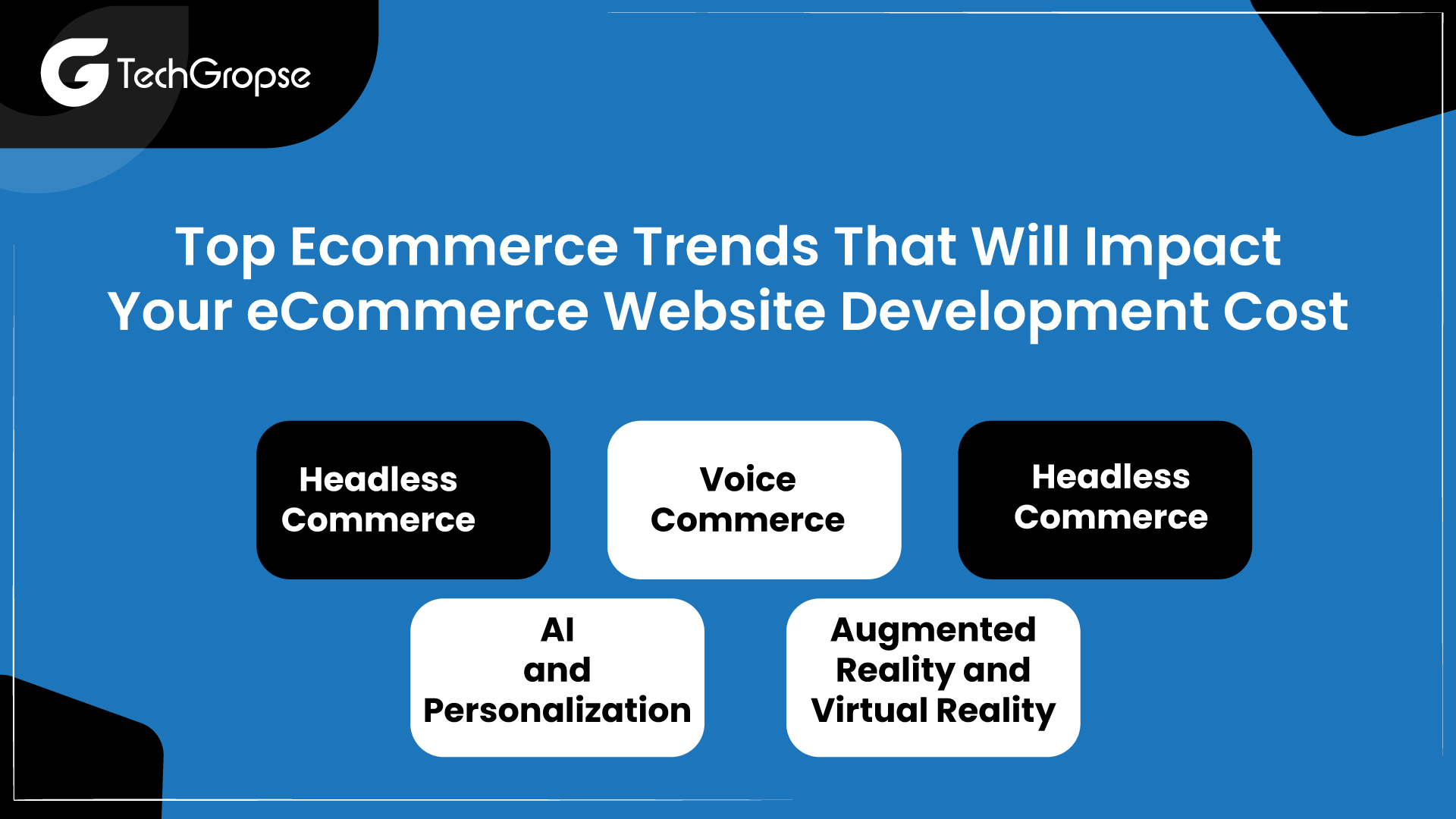
These days, lots of businesses are using outstanding online shopping websites to make more money and reach more people. It’s way better than selling stuff in a physical store because it saves money and lets you sell to more people.
In the past 20 years, online shopping has gained fame and has changed a lot. There are cool new things and ways to make customers happy.
Here are some of the top trends for online shopping in 2023 that you should think about before figuring out eCommerce website development costs.
1. Headless Commerce
- Trend Overview: Decoupling the front-end and back-end of e-commerce platforms for increased flexibility and seamless user experiences.
- Impact on Development Costs: Implementing a headless architecture may require additional development effort, especially if customization is needed for both the front-end and back-end components.
2. AI and Personalization
- Trend Overview: Leveraging artificial intelligence for personalized product recommendations, chatbots, and enhanced user experiences.
- Impact on Development Costs: Integrating AI-driven features and personalization may increase development costs, particularly for custom algorithms and seamless integrations.
3. Voice Commerce
- Trend Overview: The increasing use of voice-activated devices for online shopping, requires e-commerce platforms to optimize for voice search.
- Impact on Development Costs: Implementing voice commerce features may add complexity to the development process, including natural language processing and voice search optimization.
4. Augmented Reality and Virtual Reality
- Trend Overview: Integrating AR and VR for virtual product try-ons, immersive shopping experiences, and enhanced product visualization.
- Impact on Development Costs: Implementing AR and VR features may require specialized development skills and could increase costs compared to traditional e-commerce development.
5. Sustainability and Eco-Friendly Practices
- Trend Overview: Increased consumer demand for eco-friendly products and sustainable practices, influencing the way products are marketed and presented online.
- Impact on Development Costs: Implementing sustainable practices may involve changes in product presentation, content, and potentially supply chain integrations, affecting development costs.
6. Progressive Web Apps (PWAs)
- Trend Overview: PWAs offer a mobile-app-like experience through web browsers, improving speed, offline capabilities, and user engagement.
- Impact on Development Costs: Developing a PWA may have additional costs compared to traditional mobile responsiveness, but the benefits in user experience can be substantial.
7. Blockchain and Cryptocurrency
- Trend Overview: Exploring the use of blockchain for secure transactions, supply chain transparency, and acceptance of cryptocurrency payments.
- Impact on Development Costs: Integrating blockchain and cryptocurrency features may involve additional development effort and security considerations.
8. Subscription E-commerce
- Trend Overview: The continued growth of subscription-based models for products and services.
- Impact on Development Costs: Developing and maintaining subscription features may have associated costs, including billing system integration and subscription management.
9. Social Commerce
- Trend Overview: The integration of e-commerce functionalities into social media platforms.
- Impact on Development Costs: Implementing social commerce features may require additional integrations and customization to align with specific social media platforms.
10. Mobile-First Approach
- Trend Overview: The emphasis on optimizing e-commerce experiences for mobile users.
- Impact on Development Costs: Prioritizing a mobile-first approach may influence design and development decisions, potentially affecting costs.
To estimate eCommerce website development cost accurately, consider the specific trends relevant to your business model, industry, and target audience.
Additionally, consult with e-commerce development professionals to get insights tailored to your unique requirements.
What is The Cheapest Way to Build An e-commerce website?
Building an eCommerce website on a budget involves making strategic choices and leveraging cost-effective solutions.
Here are some cost-saving tips for creating a budget-friendly eCommerce website:
1. Use Open-Source Platforms
Choose open-source eCommerce platforms like WooCommerce (for WordPress) or PrestaShop. These platforms are free to use, and you only need to pay for hosting and any additional features or themes.
2. Opt for Website Builders
Consider using website builders with eCommerce functionality, such as Shopify, Wix, or BigCommerce. These platforms offer user-friendly interfaces, pre-built templates, and integrated eCommerce features, eliminating the need for extensive development.
3. Select Affordable Hosting
Choose a reliable yet affordable hosting provider. Shared hosting plans are often more economical for small businesses starting. Look for providers like SiteGround, Bluehost, or HostGator.
4. Utilize Free Themes and Templates
Many eCommerce platforms offer free themes or templates. Use these to make a professional-looking website without the requirement for custom design. Be sure to choose a theme that aligns with your brand and is mobile-responsive.
5. Limit Customization
While customization is essential, limiting extensive custom development can significantly reduce costs. Stick to the essential features and functionalities required for your business to keep development time and costs low.
6. DIY (Do It Yourself)
If you have some technical skills, consider building the website yourself. Use platforms like WordPress with eCommerce plugins or website builders that allow for easy customization without extensive coding knowledge.
7. Free and Open-Source Plugins
To estimate eCommerce website development cost, take advantage of free and open-source plugins to add functionality to your website. Platforms like WordPress have a vast repository of plugins that can enhance your eCommerce site without incurring extra costs.
8. Free Marketing Tools
Use free or low-cost marketing tools for SEO, social media, and email marketing. Platforms like Mailchimp, Google Analytics, and social media channels offer free or affordable plans for small businesses.
9. Consider Dropshipping
If managing inventory is a concern, consider dropshipping. This model allows you to sell products without holding inventory, as the products are shipped directly from the supplier to the customer.
Hiring the Right Professionals for eCommerce Website Development
Choosing the right online shopping app development company for eCommerce website development cost is essential for a successful and well-executed project.
Here are some factors to consider when making your hiring decisions:
1. Choosing a Reliable and Experienced Development Agency
Look for a website development company with a track record of delivering high-quality eCommerce websites. Check their portfolio, client testimonials, and online reviews to assess their reliability and experience. A reputable agency will ensure that your project is completed on time and within budget.
2. Freelancers vs. Development Agencies
Consider whether you want to work with freelancers or development agencies. Freelancers can be a cost-effective option, especially for smaller projects, but they may lack the resources and expertise that agencies can provide. The best eCommerce website development company offers a full team of professionals with diverse skills, ensuring a comprehensive approach to your eCommerce website development.
3. Factors to Consider When Hiring Developers
When it comes about hire dedicated developers, consider factors like their expertise in eCommerce development, their ability to understand and implement your project requirements, and their communication skills. It’s essential to have a good working relationship and effective communication channels throughout the development process to achieve the desired results.
Redefine Your Business With eCommerce Website Development Cost
Developing an eCommerce website is a significant investment for any business, but understanding the eCommerce website development cost factors and making informed decisions can help you achieve a successful online presence within your budget.
With careful planning and consideration, you can create an eCommerce website that not only attracts customers but also drives sales and grows your business in the competitive online market.
Furthermore, hiring experienced professionals who specialize in eCommerce website development can provide the expertise and guidance needed for a successful project.
Happy developing! Happy selling!
FAQ: eCommerce Website Development Cost
1. How much does eCommerce website development cost?
The eCommerce website development cost can vary significantly based on various factors such as project complexity, customization requirements, platform selection, design elements, and integration needs. It is essential to create a detailed project scope and obtain quotes from development agencies or freelancers to get a more accurate estimate.
2. Can I save costs on eCommerce website development?
Yes, there are several cost-saving strategies you can implement during eCommerce website development. Prioritizing key features and functionality, leveraging ready-made templates or open-source solutions, and considering outsourcing development can help reduce costs while maintaining quality.
3. How do I select the best platform for an eCommerce website?
Choosing the right platform depends on factors such as your business requirements, scalability needs, budget, and technical expertise. Conducting thorough research, considering platform features and flexibility, and assessing long-term growth potential can help you make an informed decision.
4. Should I hire professionals for eCommerce website development?
Hiring professionals for eCommerce website development is highly recommended. Experienced developers and companies have the required expertise, skills, and knowledge to ensure a high-quality, functional, and secure website.






